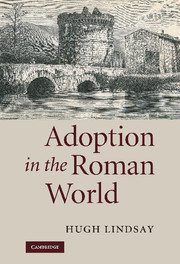Book contents
- Frontmatter
- Contents
- List of figures
- Preface
- List of abbreviations
- Introduction
- 1 Adoption, kinship and the family: cross-cultural perspectives
- 2 Kinship in Greece and Rome
- 3 Greek adoptions: comparisons and possible influences on the Roman world
- 4 Procedural aspects of Roman adoption
- 5 The testamentary adoption
- 6 Roman nomenclature after adoption
- 7 Adoption and inheritance
- 8 Roman freedmen and their families: the use of adoption
- 9 Adoption in Plautus and Terence
- 10 Sallust and the adoption of Jugurtha
- 11 Adrogatio and adoptio from Republic to Empire
- 12 Testamentary adoptions – a review of some known cases
- 13 Political adoptions in the Republic
- 14 Clodius and his adoption
- 15 The adoption of Octavian
- 16 Political adoption in the early Empire at Rome, Pompeii and Ostia; the imperial family
- Conclusion
- Glossary
- References
- Index
12 - Testamentary adoptions – a review of some known cases
Published online by Cambridge University Press: 25 January 2010
- Frontmatter
- Contents
- List of figures
- Preface
- List of abbreviations
- Introduction
- 1 Adoption, kinship and the family: cross-cultural perspectives
- 2 Kinship in Greece and Rome
- 3 Greek adoptions: comparisons and possible influences on the Roman world
- 4 Procedural aspects of Roman adoption
- 5 The testamentary adoption
- 6 Roman nomenclature after adoption
- 7 Adoption and inheritance
- 8 Roman freedmen and their families: the use of adoption
- 9 Adoption in Plautus and Terence
- 10 Sallust and the adoption of Jugurtha
- 11 Adrogatio and adoptio from Republic to Empire
- 12 Testamentary adoptions – a review of some known cases
- 13 Political adoptions in the Republic
- 14 Clodius and his adoption
- 15 The adoption of Octavian
- 16 Political adoption in the early Empire at Rome, Pompeii and Ostia; the imperial family
- Conclusion
- Glossary
- References
- Index
Summary
Testamentary adoption seems to be used in situations not significantly different from inter vivos cases. The main difference is in the timing. There is still a focus on choosing close kin or close friends. The purpose also remains similar. An elite testator has the capacity to provide his testamentary heir with financial resources and some of the attributes of his social standing, such as his domicile, slaves, freedmen, and political connections, whether in the form of clientela or ties to other influential Romans. Those of lesser status would have less to offer, but the situation was generically similar. From the perspective of the parties to a testamentary adoption, there was no need to develop a close personal relationship, but in most cases this probably existed in any case. Relatives could be suspected of being attentive to their childless kin with ulterior motives, as will be seen in the case of Atticus, who thereby secured his maternal uncle's estate.
adoption by maternal kin
Maternal relatives are quite prominent as testamentary adopters. In one of the earliest known cases, the maternal grandfather was the adopter. The adoptee was a son of P. Cornelius Scipio Nasica (pr. 93 bc), and his mother, Licinia, was the daughter of the orator L. Licinius Crassus (cos. 95 bc). The orator died in 82 bc, a victim of the Marians, so this must have been the date of the inheritance (Münzer [1999] 255–6; cf. Kunst [2005] 141).
- Type
- Chapter
- Information
- Adoption in the Roman World , pp. 160 - 168Publisher: Cambridge University PressPrint publication year: 2009



